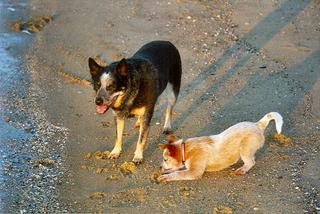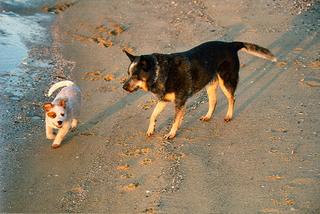Dusty has entered what is known as the 'fear period'. Puppies develop a fear of the unknown
at around twelve weeks.
On our walk this morning she startled at the kookaburras dawn chorus, at rowers on the river, at a pelican coming in to land, and at a large woman on a bicycle wearing some sort of flowing cape thing (to be fair to Dusty I startled at that too).
She came to attention, backed off, and gave a woof-woof of suprise. Being a puppy with a very sound temperament, Dusty recovered quickly from her fright, marching up to the kookaburras perch, following the rowers and the pelican on the river, and watching the bicyclist out of sight.
My response to the fear period is to do nothing. Reassuring her could reinforce fearful behaviour, and anyway this whole developmental period is about her coming to terms with new things in her environment in her own way. My no-reaction to new things will reassure her that it is nothing to worry about. I will however takes steps to avoid things that I know will be frightening until she has developed her own mechanisms for coping. For example behind the fish markets are huge fans that come on with explosive noise and wind at seemingly random times - frightening the bejesus out of Thommo and I - so we'll stay away from there until she is older.
Klinkam talks about the
practice of overstating and even abusing the behavioral concept of the "fear period" by accepting that it is normal for a pup to show protracted, chronic fearfulness of ordinary environmental stimuli. Contrary to a common misperception, the Fear Imprint developmental phase is not fearfulness, it is an awareness of what is 'new'. "The sound pup demonstrates the capacity and the will to identify that something encountered is novel, investigate to determine if it is benign and it need not be feared, accept it as a familiar (known) environmental element, and recognize future encounters as non-threatening and inconsequential that do not provoke a fearful response."



 Puppy's ears standing up really changes her appearance - it is a little bit sad as it represents the end of the baby puppy stage.
Puppy's ears standing up really changes her appearance - it is a little bit sad as it represents the end of the baby puppy stage.
